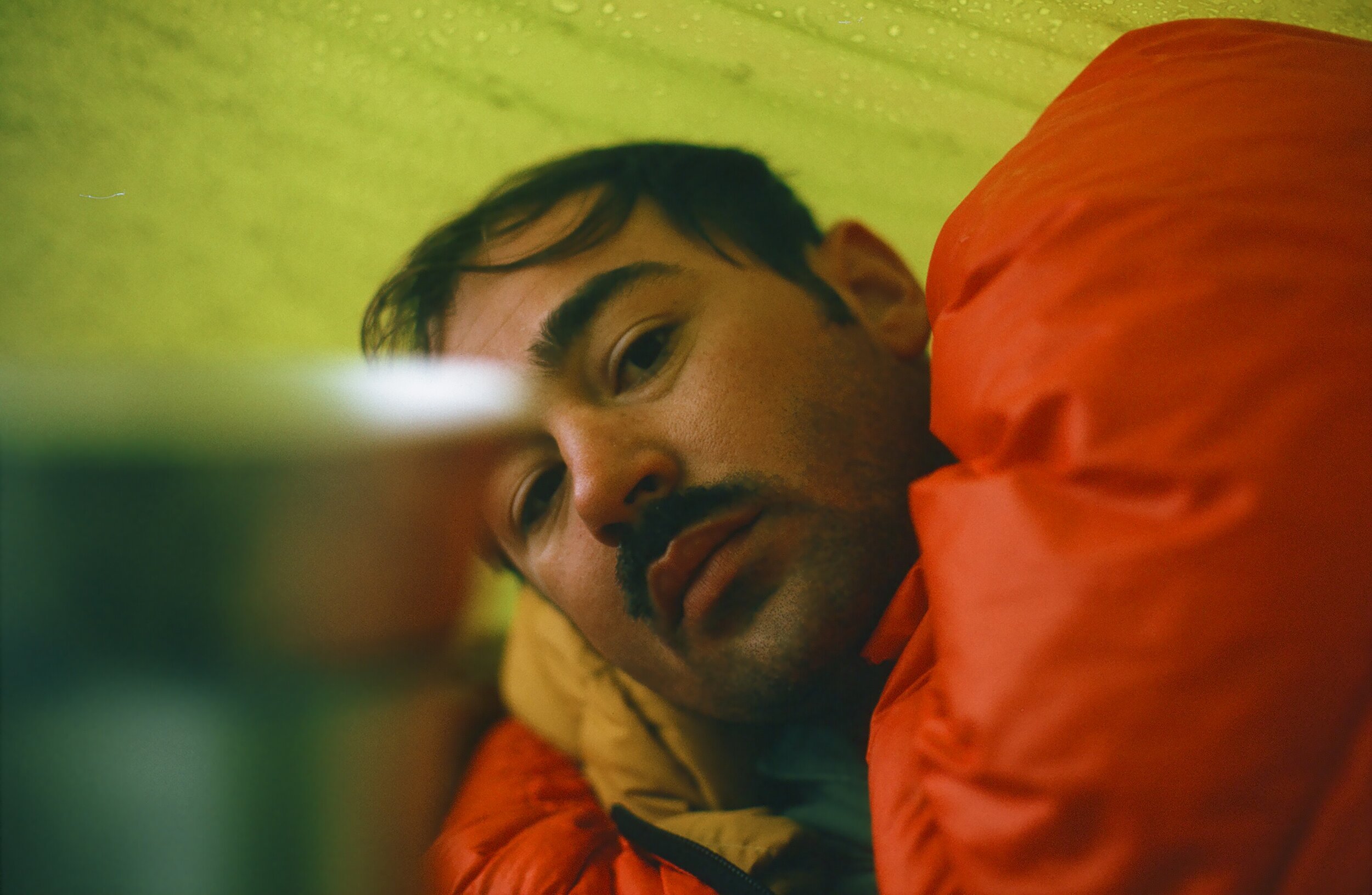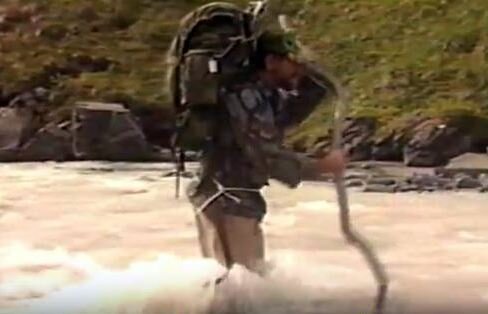Weather
Weather is one of the major factors for a successful hunt. Even more so on planned short hunts or hunts with specific dates that can’t be changed. Short seasons with bad weather can blow the entire season and there’s nothing you can do. In fact, this past sheep season I wanted to celebrate my 75th birthday in sheep country but because it had rained hard every day in the area that I planned to hunt the week before opening day, I started thinking it was a no go. It was also supposed to rain some during the first week of our hunt dates. There were reported mudslides in the area and all the creeks were swollen. We chose not to attempt accessing the area. A friend who had hunted the area for the previous five years tried going in that area but got stuck in the first mudslide about 100 yards up the trail and there was no way to proceed with the creek out of its bank. They cancelled their hunt. Our decision not to go was apparently a wise one.
Earl Boucher out checking the tarp during a snowstorm on one of our weekend goat hunts. We placed one of our packs on each end of the tarp to block the wind, rain or snow. One of our unsuccessful hunts.
Earl enjoying his sleeping bag during the snowstorm.
Hunters in Alaska have to deal more with bad weather than those in most of the other 49 states. It’s also hard to forecast our weather because of all of our mountain ranges. That makes it difficult to make a good decision on whether to go or not. As a resident hunter who took many weekend hunts, I spent lots of time in the rain especially in the fall. Mountain hunts are the worst because the rain normally comes with low clouds blocking the visibility of the area that you are hunting. If you are camped in the mountains you are usually in the clouds, so you’re in the tent or whatever your shelter is. I used a piece of visqueen or a tarp most of the time. On those bad weekends I spent lots of time wet waiting for the clouds to lift or, if it was also windy hoping my shelter wasn’t going to take off. I’ve spent more than one night like that. One night, was spent with water running under my air mattress through the tarp. Not fun!!
Just relaxing under the visqueen shelter while it was raining outside.. I was in my late 20’s.
Skip Phillips trying to stay warm as we prepared breakfast after waking up to snow. Another unsuccessful weekend sheep hunt.
If you were on the Alaska Peninsula with all the major storms that come through you stayed wet and cold. With winds up to 100 miles an hour you were always praying your tent wasn’t going to blow away. I had a bear hunt like that in the Cold Bay area in the late ’70’s where the winds were clocked at over 100 MPH and blew the refrigeration unit off the Reeve Aleutian Airways freezer that was next to their hanger. The rains flooded the Joshua Green’s left-hand valley floor and we had over a foot of water in the tent. We were in the right-hand valley at that time in another tent. It didn’t flood but we thought in that wind the tent was going to come apart. Those are not fun times but something that you have to deal with as hunters.
Trying to keep our tent from blowing away in winds that reached 100 mph. It was amazing that with little cover the tent hung in there.
If the weather was too hot while hunting in glacier country you had to worry about not being able to cross the swollen glacier streams because of the ice melting. I have been forced to cross raging swollen streams or sleep on the other side of the stream and waiting until the next morning for it to go down.
Crossing glacier fed Canyon Creek in 1987.
If you are using a boat to access your hunting area during those storms you had better be in a protected cove or on shore. If you are using a small aircraft you better be on the ground and tied down. Then all you have to worry about is if your plane will be destroyed. Always anticipated, and never fun.
Waiting out a Cold Bay storm. One of many.
In the guide business you have hunters coming in and going out on specific dates so the weather must cooperate for them to get in and out of camp. One of the reasons that most hunts are for 10 days is because of our bad weather conditions. If you get a five-day storm you still have time to hunt but If you have back to back storms it’s almost impossible to deal with but somehow you do. Also, when you have six to eight hunters in the field at a time you have to service all the spike camps. We tried to check on each camp every two or three days but weather usually dictated our schedule. As an outfitter I have said on numerous occasions if I could control the weather, we would be 100% successful. I truly believe that.
My wife Karen waiting for the clouds to lift. We waited there for over two hours while it rained, then snowed and then back to rain and the clouds never lifted. We were less than 200 yards from the top of the ridge and had two legal rams (one at least 39+”) laying about 150 yards below the ridge. We pulled off. See post “Hunting with My Wife.”
I remember the start of one spring brown bear season on the Peninsula, we were in a major wind storm and on opening day we had ten clients still in base camp without guides. We had flown the guides into spike camps two days before and then picked up the clients in Pilot Point when the winds came up to over 60 MPH and blew like that for three days. When the winds finally subsided on opening day, we were able to fly the clients into their spike camps. They all lost a day of hunting because of the Alaska law that states, “no hunting the day you fly.” You can also read my post “God Saved Me” where a wind storm came up when we were going across Cold Bay in the Zodiacs to pick-up our spring brown bear hunters. My Zodiac was flipped over in the bay by 50+ MPH winds. Back in the day we had no dependable commutations for weather checks so we were on our own when it came to weather reporting or forecast. We had small radios at the Dog Salmon River and Otter Lake base camps where we got marine forecasts twice a day on the public radio stations. That let us know when major weather systems were coming. You can also read my post “Cub in The Lake” where my super cub was blown into Otter Lake. That 60+ MPH wind wasn’t forecasted but that’s what we as outfitters had to deal with. I think the most dangerous part of the guide business when it comes to weather is flying. The high winds and low clouds create so many dangerous situations. You can read about some of them in my posts “Flying the Super Cub” and “Forced To Land.”
My “super cub” was blown into Otter Lake by 60+ mph winds that weren’t forecasted.
Trying to set-up a tent in 35 mph winds after being forced to land by snow and clouds. Karen is in the cub taking the picture. The next day was a cold blue bird day like it was forcasted to be this day.
We were always dealing with major fall storms that flooded the Dog Salmon base camp annually and, excessive glacier melt from some of the hot summers flooded us completely out of our Bryson Bar base camp. The river is still running through that camp. You can read more about the floods in my post “Hell and High Water.”
Major flood waters at the Dog Salmon River base camp.
The flooded runway at the Dog Salmon River base camp.
Our Bryson Bar base camp after the Chitina River changed channels during a couple of hot summers melting numerous glaciers in the area.
So, you can see what Alaska hunters must deal with when it comes to weather and guides even more so because of the length of time that they spend in the field some up to 120 days a year. Even dealing with the weather, AAA Alaskan Outfitters and many other guide services come close to 100% success. It’s a tough business but it’s rewarding helping hunters with their hunt of a lifetime, bad weather and all!













